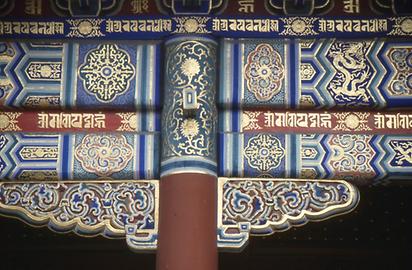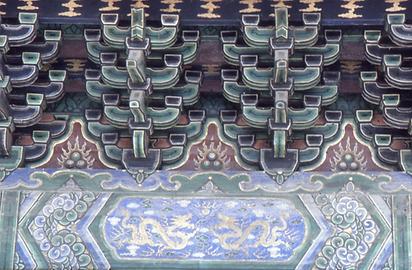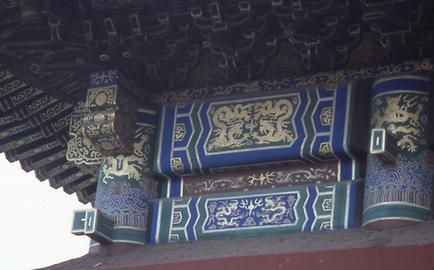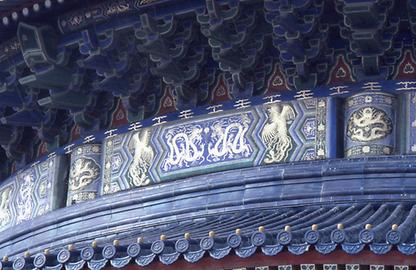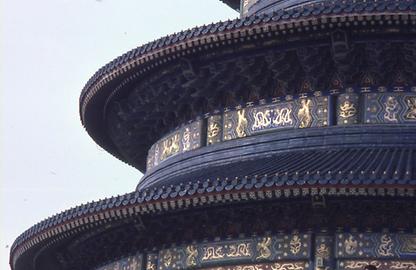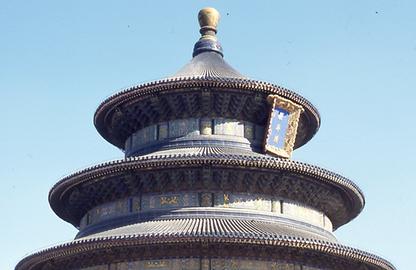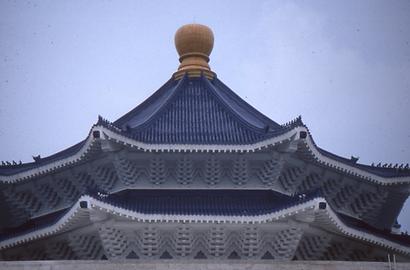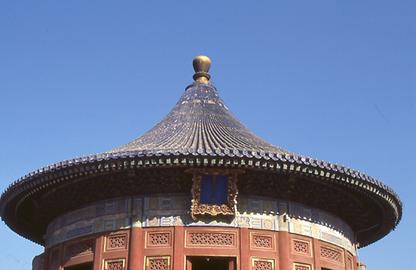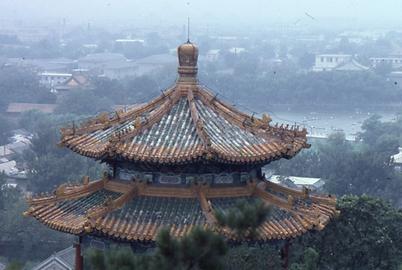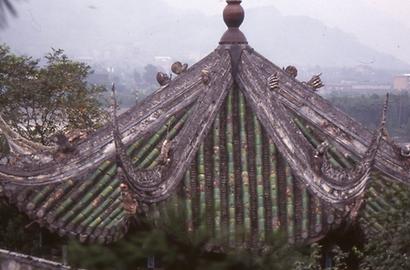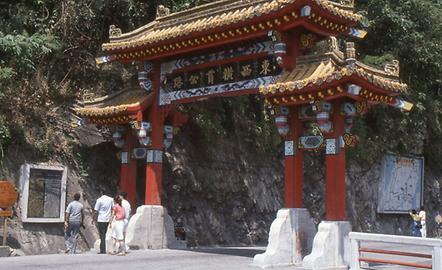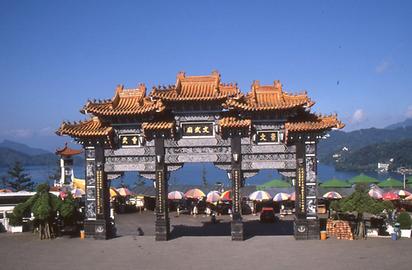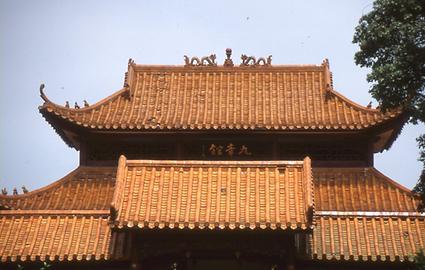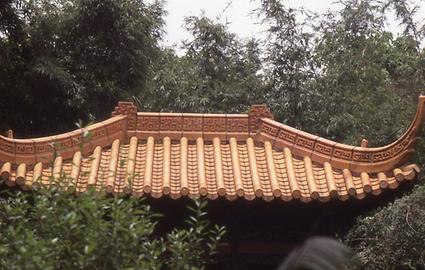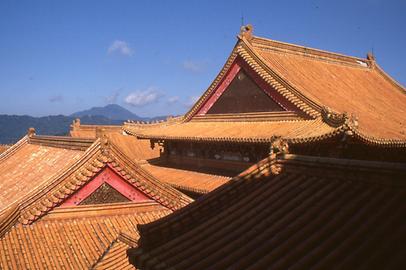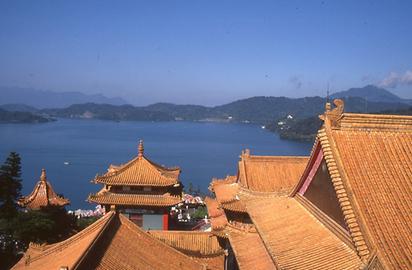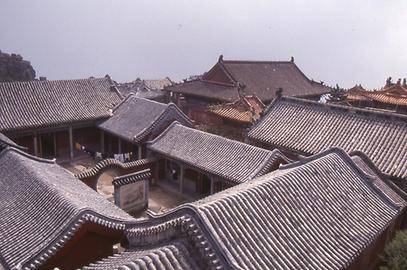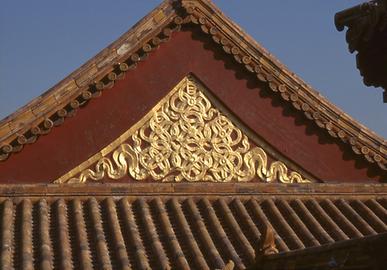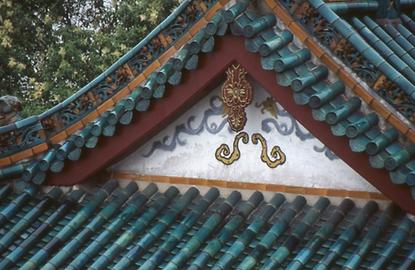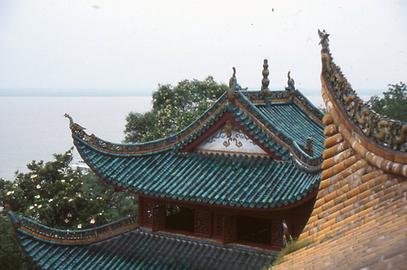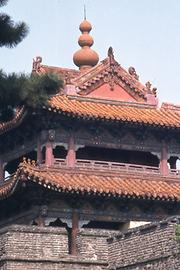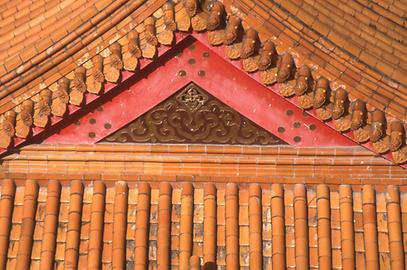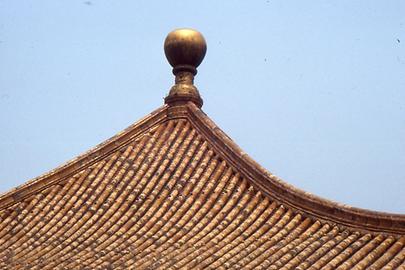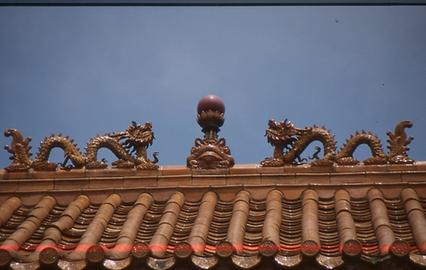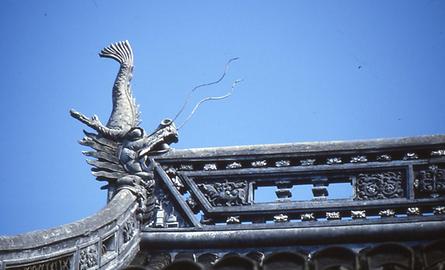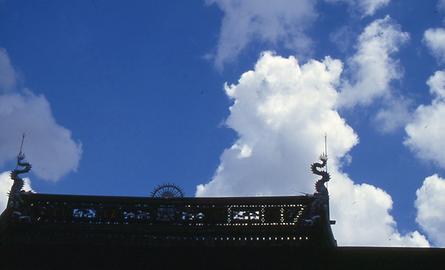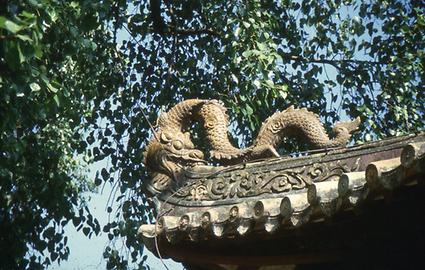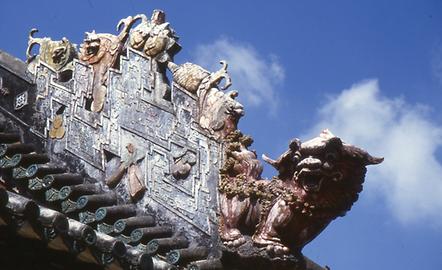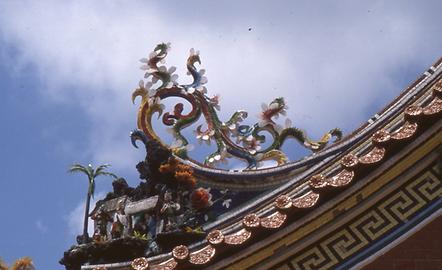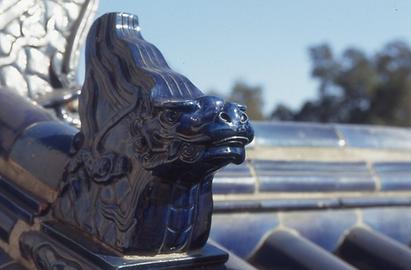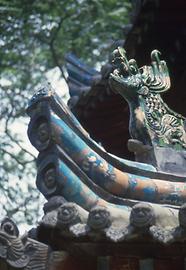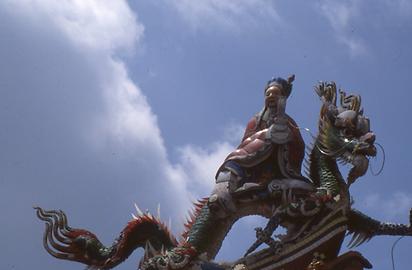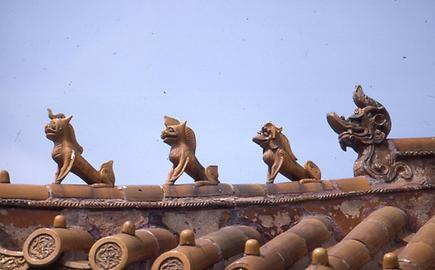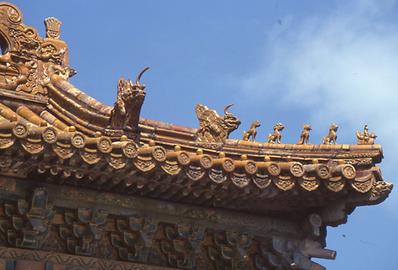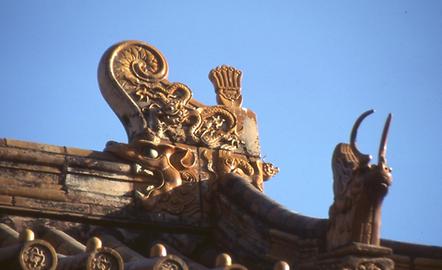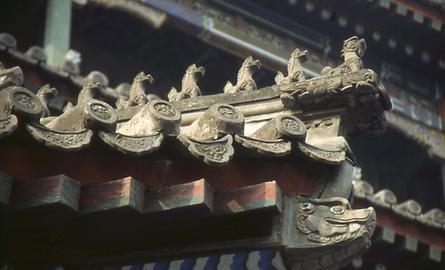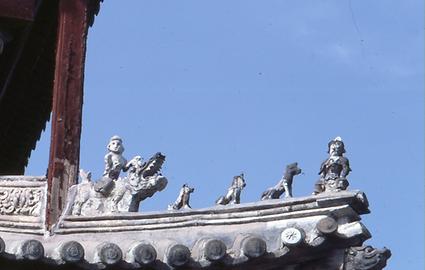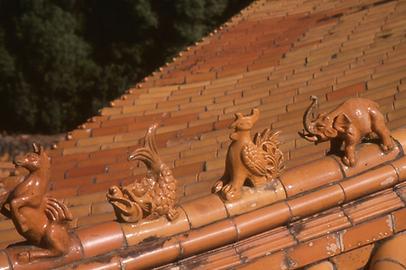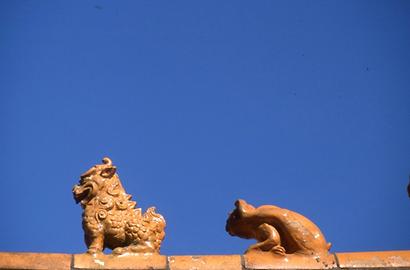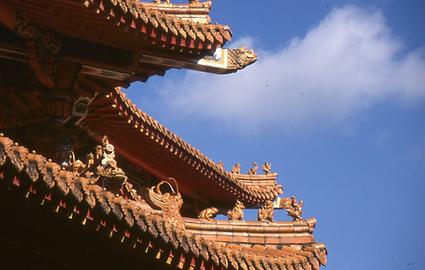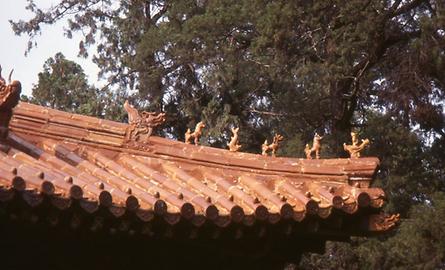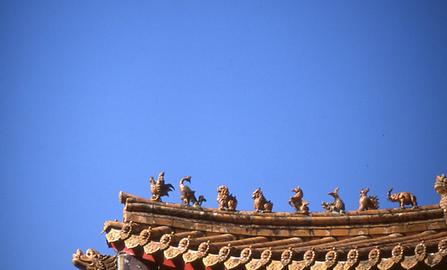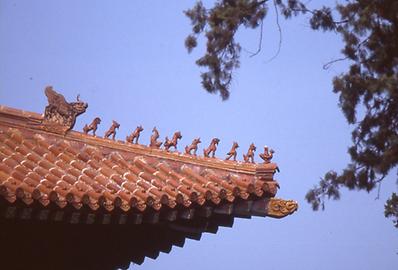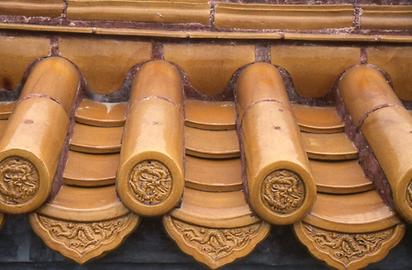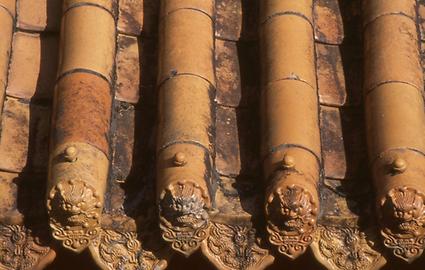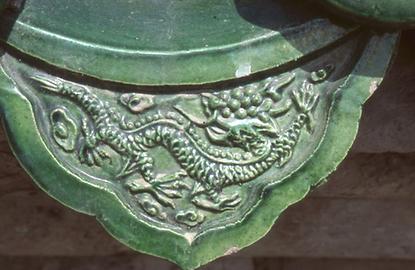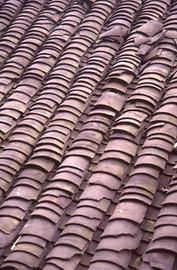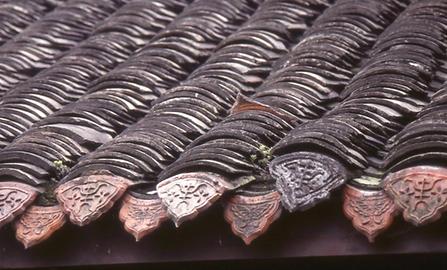The Chinese Roof: Art of curving lines#
By Günther JontesThe illustrations for this essay were taken by the author in the years 1982, 1986, 1988, 1991, 1994, 1996, 1997, 1999 and 2005. They are part of the archive "Picture flood Jontes"
In the pictorial ideas of the Europeans of the Middle Kingdom along motifs such as the Great Wall, steep cliffs with bizarre pines, illegible-beautiful characters also buildings with elegantly curved roofs, decorative figures and colorful glazed bricks can be found.
And indeed, these roofs are a very important element of Chinese architecture and Far Eastern aesthetics in architecture. The Chinese house, be it imperial palace, temple, aristocratic residence, but also peasant or urban bourgeois house, places its emphasis on the horizontal and achieves monumentality like a vertical structured builing. Verticality is little emphasized and is dissolved by the dynamic roofs. It can be said that the building itself looks relatively simple, but through the ridge and the curved roof it gets the desired dynamic.
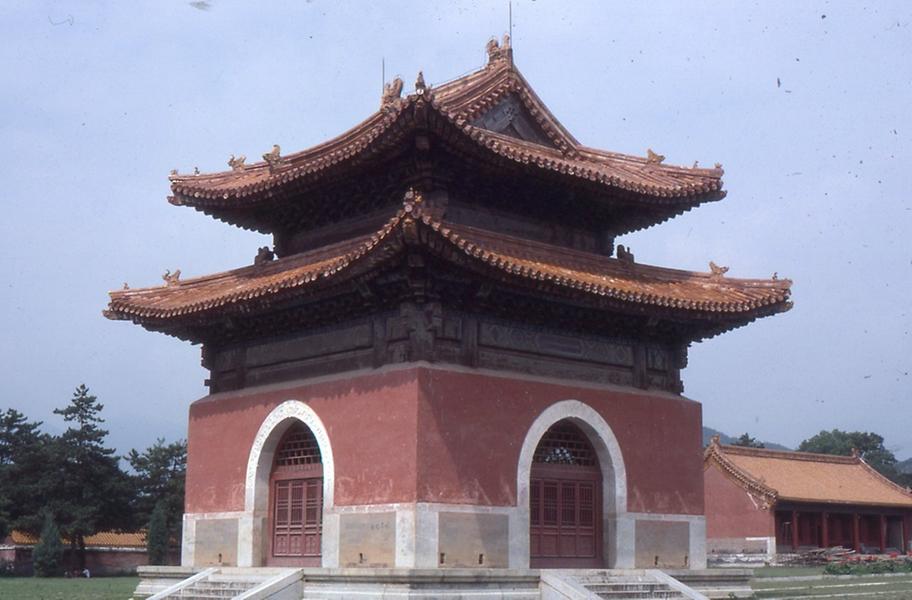
As roofs weigh heavily, they are supported by pillars both inside and out. It is also significant that the assembly of the components is not done by iron nails or clamps. Rather, the parts of the system are put together ingeniously and form a seamless unit.
The zones between stacked double or triple roofs also provide room for rich, scenic jewelery, in which the dragon and its counterpart, the Phoenix, are among the most common elementsn
Important buildings are located on stone terraces (chin tái). This not only provides protection against rising dampness, but also enhances the monumentality of the horizontal layered structure. The classical ancient Greek architecture has also made use of this "trick". In China, the multi-storey, towering pagodas tend to be the exception. Their construction principles correspond more to religious and cultic requirements. A middle thing between pagoda and symmetrical building is the round temple, as is shown, for example, in the Beijing Temple of Heaven and its axial outbuildings.
The construction on the so-called coal hill north of the Beijing Forbidden City also follows these guidelines. Because of steps in its roofs it even appears more dynamic than the Temple of Heaven.
Freestanding towers are also constructed according to the same principles. Here, the horizontal part sometimes merges directly into the roof zone.
Another element is the symmetry of the buildings, which in the case of palaces and temples follow as a whole a higher axis into which they are organically integrated.
The orientation towards the wind directions also plays a role, which is determined by the geomancy (Chinese: feng shui "wind and water"), because according to ancient tradition it is able to emphasize good elements and to eliminate the bad ones. In the north it can be a mountain, in the south of the building (of the whole arrangement), even if is a grave, a watercourse or pond can provide the desired balance.

When structures are very close to each other for functional or topographical constraints, they are always at right angles to each other. This creates attractive clusters that can provide the eye with a wealth of simple elements and yet have an unexpected sophistication.
The gable surfaces as the result of the tent-like construction and the symmetrical axis provide space for ornamental designs. However, they are not located in the central viewing plane.
The classic Chinese building material is wood, although buildings made of red and gray bricks made of burnt clay were used in areas with little wood. The roof, however, has always been built of wood and covered with ceramics for craftsmanship and architectural structure. Wooden buildings are earthquake-proof - in China this danger always threatens! - but at extreme risk of fire. For this reason, in the area of the Forbidden City in Beijing, large bronze vessels with water to fight a potential fire can be found at regular intervals. They can even be heated in the cold winter of northern China to prevent freezing.

The pointed roof rafters are often crowned with a finishing element. Golden spheres are probably to be understood as stylized closed and their purity-preserving lotus blossoms.
In the case of gates and roofs, buildings of some importance also have beautifully framed upright panels bearing inscriptions with the name and character of the building. In the last, the Qin Dynasty, these inscriptions are always written in Chinese characters and top-down Manchurian script: The Manchu people, who ruled the Middle Kingdom from 1644, had fully absorbed Chinese culture but paid attention to publicly show certain idiosyncrasies like their minority language as equivalent to the Chinese.
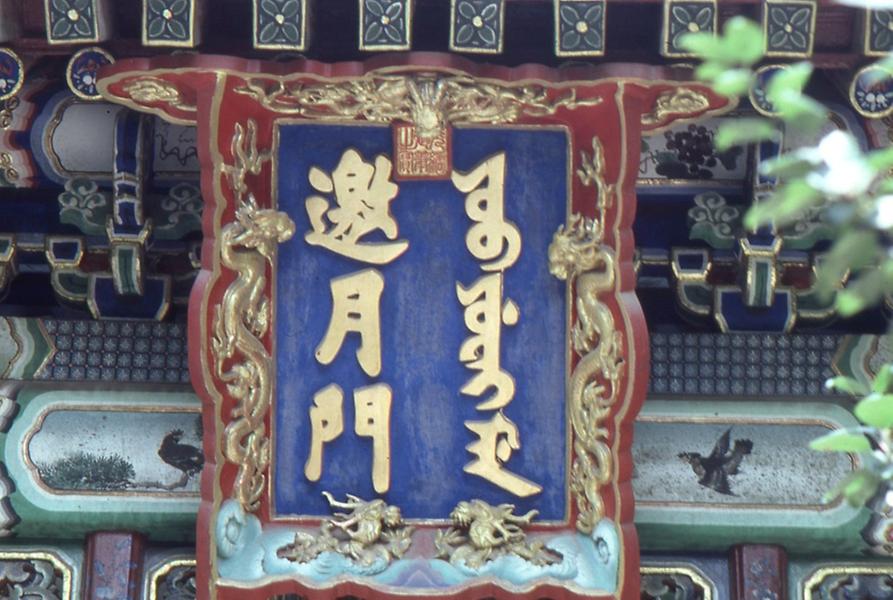
This is particularly true of religiously constructed buildings erected by rulers of the last dynasty, who had also been initiated into Tibetan Buddhism. Here are, from left to right, even four different scriptures and languages: Mongolian, Tibetan, Chinese and Manchurian.

Dragons and whole processions of mythical beings#
Many of the ridges and curved roofs also carry figurative jewelry, which may consist of glazed ceramics, but also metal or wood carving. Often the ends of the ridge show dragons. This has been interpreted as protection against lightning, because a lightning strike would have meant fire in most cases and thus the end of timber construction. It was hoped that the heavenly thunderbolt would avoid the dragon and find its way to Earth, leaving the house untouched. Today, this is done by means of technical lightning conductors, to protect historically important buildings. One can imagine what catastrophe it must have been when just the imperial heavenly temple burned down in 1889 after a lightning strike. What is seen today is an exact copy made in 1890 using traditional materials and techniques. Without the temple, the imperial sacrifices to the heavenly powers could not have taken place.
Even swords can protect the neuralgic points of the roof structure in a magical-spiritual way from lightning.
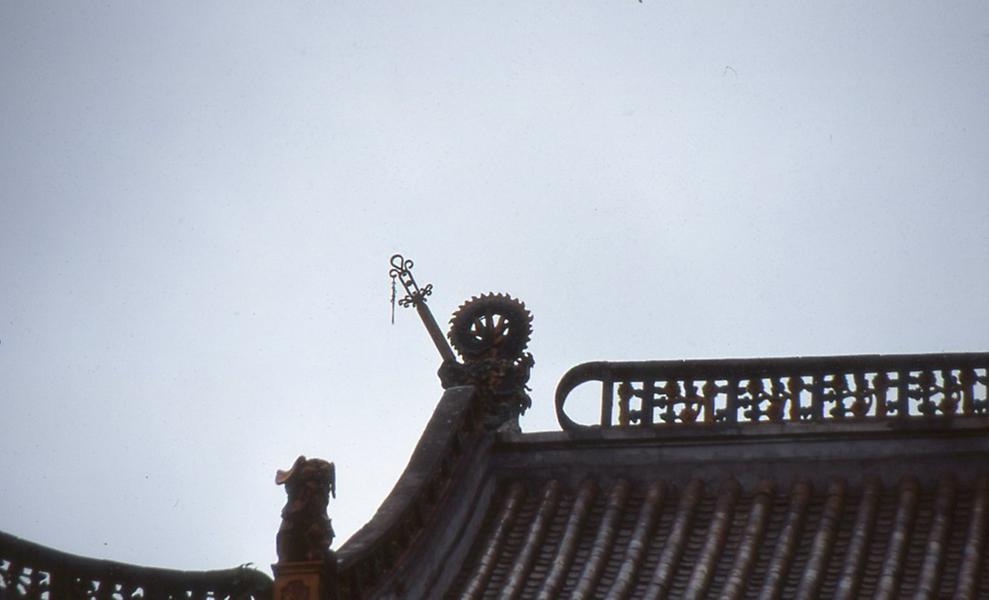
The most trusted were rows of small, on the ridge of the rafters running figures, the made of burnt clay and glazed, mythical creatures or real animals. One can easily recognize horses, elephants, rabbits, chickens and dolphins.
Among the mythical beings are also figures of the immortals, the dragon (chin long) and its female antipode Phoenix (Chinese feng), lion, the sky and the sea horse, the mythical creatures Suangyi and Xiezhai and a fish-like hybrid creature.
These figures are variable in their order. Such "roof processions" exist since the Ming Dynasty (1368-1644). Earlier buildings of this construction type have not been preserved. Thus, Tang Dynasty (7th-10th century AD) buildings can only be seen from models, reliefs or paintings. Written descriptions of glazed building ceramics have been around since the Wei dynasty (220-265 AD)
Even roosters are used at the tips of a roof. They are considered a symbol of the sun, as they are the first to greet the new day. Their crows scare the evil spirits that could threaten the house and its inhabitants. This idea is an ancient Taoist heritage.
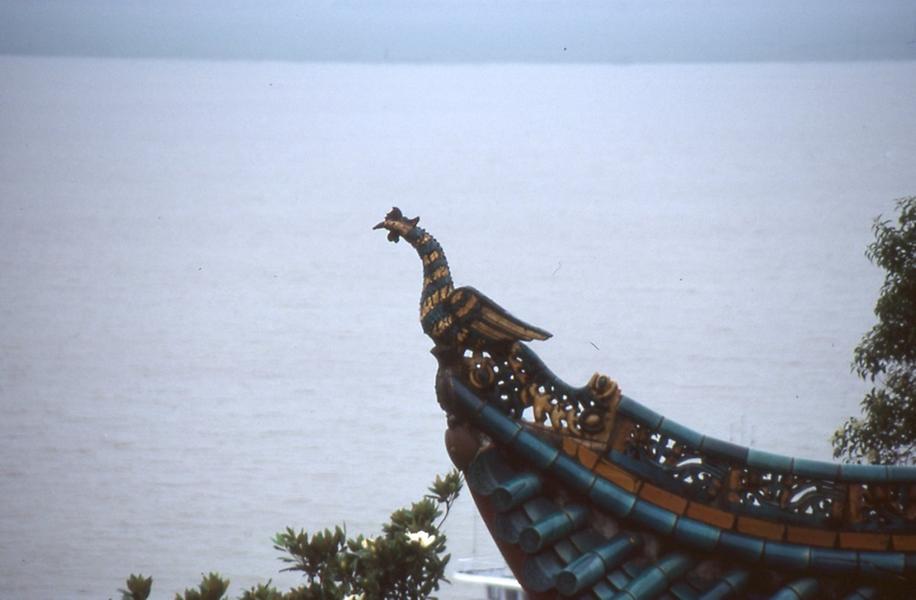
One of the figures, however, is modeled after a historical figure. It is always the furthest out and depicts the hen-riding prince Min Qi (479 - 502 AD) of the Qi Dynasty, who had been the ultimate coward. When his subjects were threatened in a war, he abandoned them and fled. As soon as peace reigned, he was in retaliation built onto the last rafters and so his shame was revealed.
The higher a building is rated in its spiritual value, the larger the number of figures. At the Hall of the Highest Harmony in the Forbidden City in Beijing, the highest possible 12 number is attained.
The covering of the roofs uses different types of bricks for the ridge and the other parts, corresponding in function to the European roof tiles of classical antiquity according to the principle "monk and nun". The colors of the glaze are also important. Only imperial buildings were allowed to wear the noble yellow. This was originally a symbol of the northern Chinese loess soil and, since the 6th century AD, it stood for the son of heaven, the emperor, to whom all land belongs. One unmistakable proof of the political deification of the Mao Tse Dong was that the roofing of his mausoleum on Tiananmen Square in Beijing was laid out in imperial yellow.
The tile-roofing of the Imperial Temple of Heaven in Beijing is a noble blue in reference to its name.

In contrast, the earth temple as a counterpoint to the imperial heavenly temple bears the color green associated with the earth and its vegetation.
The coloring of the bricks can also emphasize the transition of the architecture into the nature of the environment.
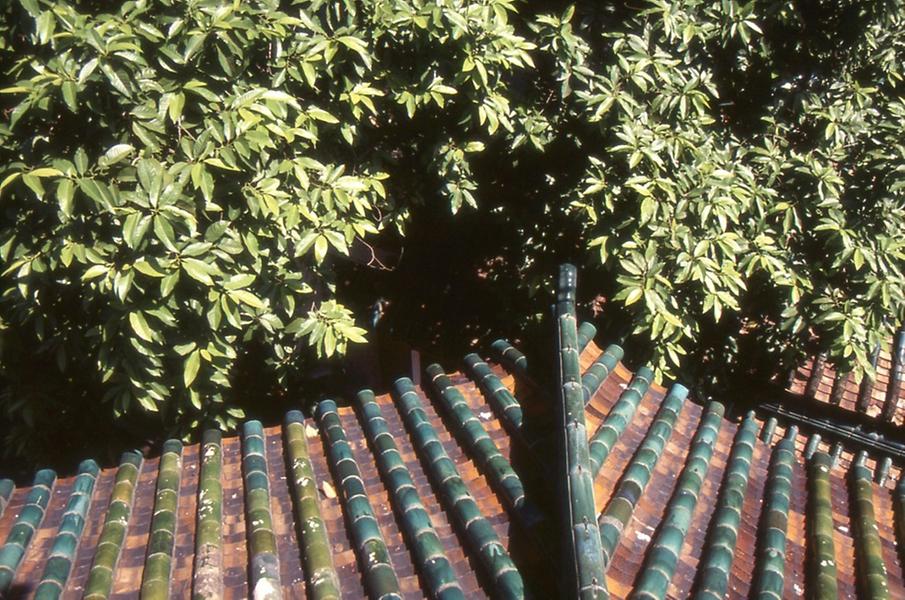
The folk architecture of the villages and towns uses only unglazed, neutral colored roofing.
LiteraturE#
- Ernst Fuhrmann, Das Tier in der Religion. München 1922
- Eduard Fuchs, Dachreiter. München 1927
- Thilo Thomas, Klassische chinesische Baukunst. Zürich 1978
- Rainald Simon, Chinesische Baukeramik: Dachreiter und Schmuckziegel, Museum für Kunsthandwerk. Frankfurt/M. 1984 (Kleine Hefte 23)
- Heinz Zanger, Dachschmuck aus gebranntem Ton. Suderburg-Hösseringen 2002
